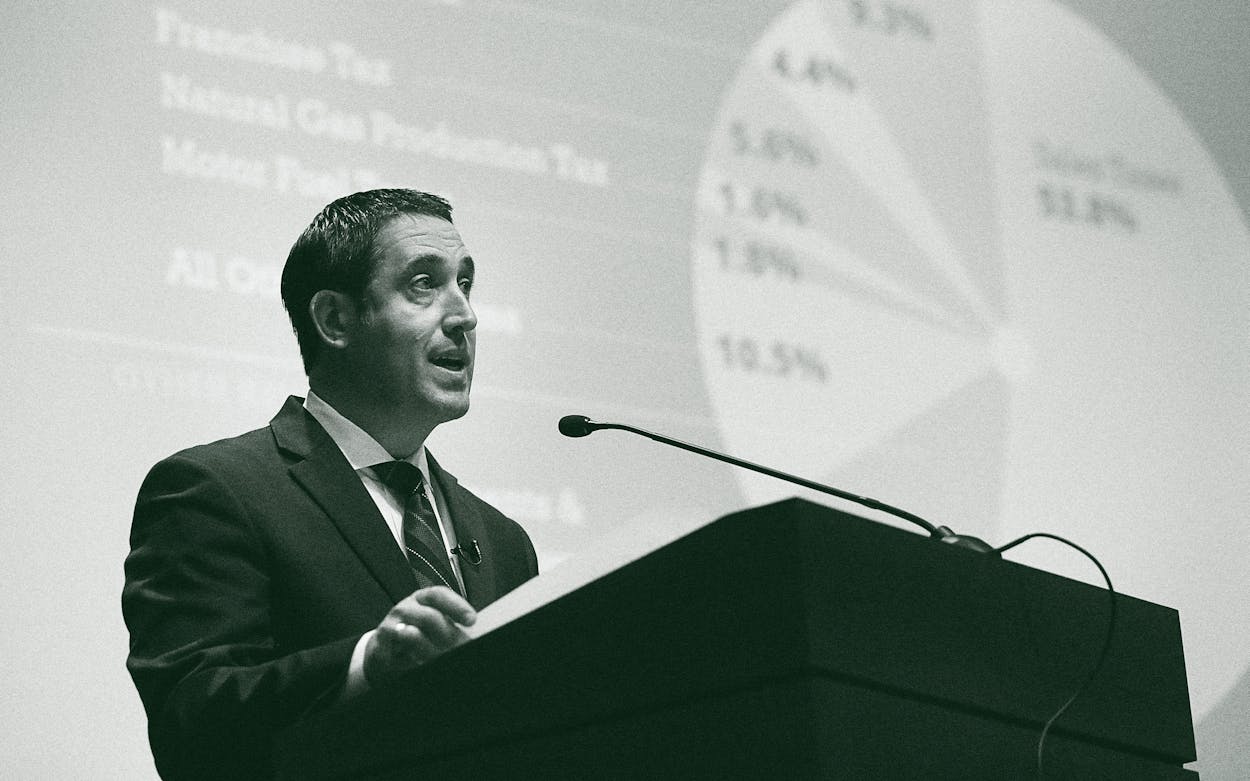After the collapse of oil prices and the economic contractions following the spread of the coronavirus early last spring, Governor Greg Abbott and other state leaders worried about a state budget deficit as large as $4.6 billion. On Monday, ahead of the convening of the Texas Legislature, comptroller Glenn Hegar offered a sunnier, though still concerning, picture. For the current budget cycle, which ends in August, the Republican projected that revenues will fall short by a more modest $1 billion, spurred by a rebound in consumer spending and the oil and gas industry. And for the next budget period, which begins in August and runs through August 2023, the state is estimated to have $6.3 billion less than the previous cycle, though budget-writers had unusually healthy tax revenues to work with when the Lege met in 2019.
All told, Hegar predicted that the Legislature will have about $113 billion in general revenue discretionary funds available for the 2022–2023 budget. While the state avoided a fiscal bloodbath, Hegar said the Legislature will still face “some difficult choices to balance the budget.”
To do so, lawmakers can tap into the state’s $10.5 billion rainy day fund, cut spending, plug tax loopholes, or look for alternative sources of revenue, such as taxes from legalized marijuana or gambling. If the revenue estimate had been worse, cuts in spending for schools or for services for the poor would have been inevitable, and opening new tax sources might have been on the table. Given the less-than-dire shortfall, there are two areas the Legislature will likely focus on instead.
First, lawmakers will have to decide whether to continue to fully fund the property tax cuts and increased school funding package that Governor Greg Abbott signed into law in 2019. Flogged by Abbott and other top Republicans as part of a “kumbaya” session that delivered on pocketbook issues, the reforms had no ongoing source of revenue to support them and instead were supposed to be funded by increased economic growth.
At the time it was passed, some predicted that the cost of the program would increase from $11.6 billon to about $13.6 billion for the upcoming biennium. The pandemic-related decline in school attendance means that the cost may be smaller. But the still-sputtering economy may make it difficult to deliver on the promise of sending more money from the state to school districts.
When asked whether money would be available to pay for the full property tax cuts and increases in school spending, Hegar demurred. “As long as the state economy continues to grow, that enables the Legislature more flexibility to meeting the obligations they have agreed to in the past,” he said. In other words, he only counts the pennies coming in. It is up to the Legislature to decide how to spend them.
The other major choice lawmakers must face is how to pay for Medicaid. Two years ago, lawmakers cut the federal health-care program for the poor by $900 million and intentionally underfunded its future costs—an accounting trick that the Lege often uses. It is difficult to predict how much the Lege will be forced to spend in an emergency allocation to make up for the underfunding.
Hegar, who was a state legislator during the past two major budget shortfalls, stressed that this biennium’s deficit is not the worst he’s seen. “This budgeting cycle, while the Legislature still is going to have to make some tough budgeting decisions, it is not anywhere compared to where 2011 or in my opinion 2003 was, fortunately for the Legislature, fortunately for all of us in Texas,” he said.
In 2003, the state faced a budget gap of $9.9 billion, after the recession triggered by the 9/11 attacks and the dot-com bust. To balance the budget without major cuts or raising taxes, lawmakers and Governor Rick Perry cut allocations to colleges and universities, while removing caps on tuition to help schools offset decreased aid from the state. As a result, the cost of attending Texas universities increased an average of 23 percent statewide, and as much as 40 percent at some schools, within two years.
In 2011, after the Great Recession, state legislators faced a $27 billion shortfall. That year the main target of cutbacks was public education. The Legislature cut funding for schools by $5.4 billion, prompting an almost immediate layoff of hundreds of teachers and triggering the local property tax increases that Abbott would later cap in 2019.
While painful cuts to public education are unlikely to be necessary this year, Hegar said the forecast “remains clouded with uncertainty.” If the virus is brought under control, consumer spending could increase, but if it spreads further, revenues could take a large hit. “The ultimate path of the pandemic and the behavior of consumers and businesses during a resurgence are difficult to gauge,” he said.
- More About:
- Politics & Policy
- Texas Lege
- Glenn Hegar






